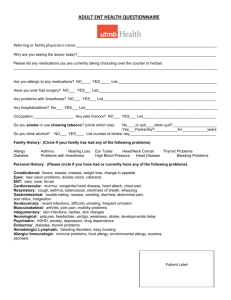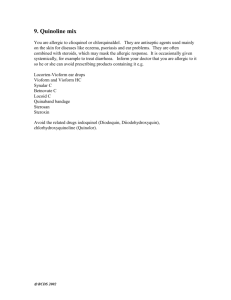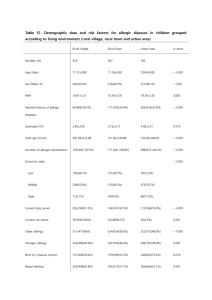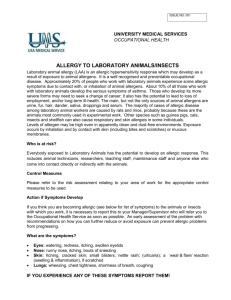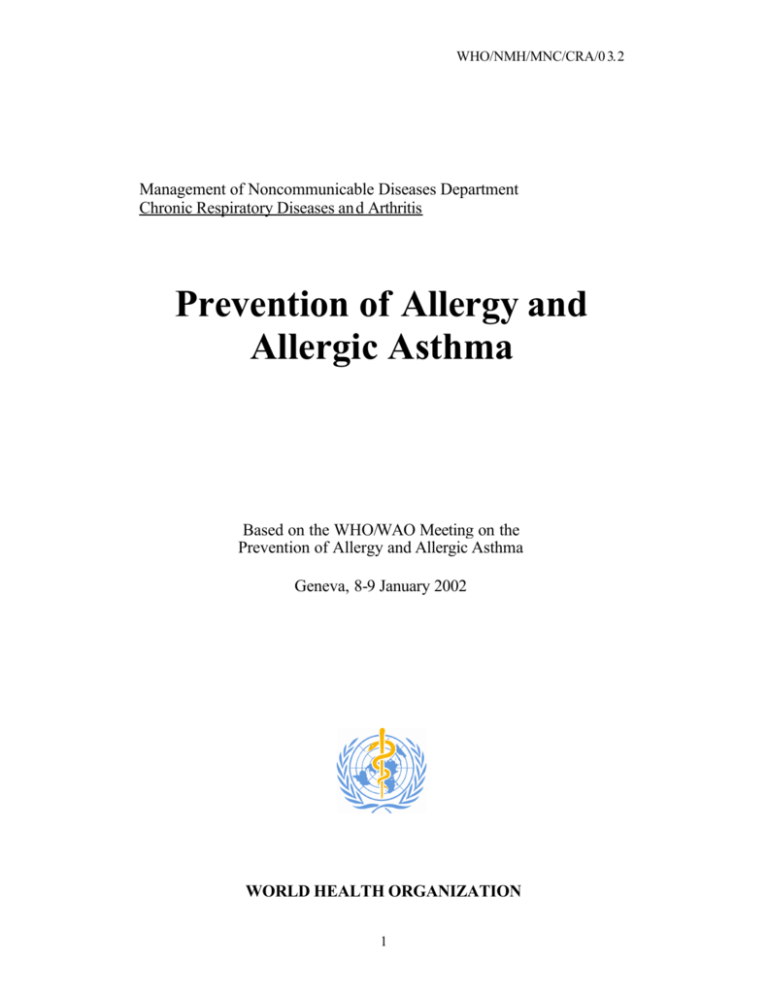
WHO/NMH/MNC/CRA/0 3.2
Management of Noncommunicable Diseases Department
Chronic Respiratory Diseases an d Arthritis
Prevention of Allergy and
Allergic Asthma
Based on the WHO/WAO Meeting on the
Prevention of Allergy and Allergic Asthma
Geneva, 8-9 January 2002
WORLD HEALTH ORGANIZATION
1
© World Health Organization 2003
All rights reserved. Publications of the World Health Organization can be
obtained from Marketing and Dissemination, W orld Health Organization, 20
Avenue Appia, 1211 Geneva 27, Switzerland (tel: +41 22 791 2476; fax: +41 22
791 4857; email: bookorders@who.int). Requests for permission to reproduce or
translate WHO publications – whether for sale or for noncommercial distribution
– should be addressed to Publications, at the above address (fax: +41 22 791 4806;
email: permissions@who.int).
The designations employed and the presentation of the material in this publication
do not imply the expression of any opinion whatsoever on the part of the World
Health Organization concerning the legal status of any country, territory, city or
area or of its authorities, or concerning the delimitation of its frontiers or
boundaries. Dotted lines on maps represent approximate border lines for which
there may not yet be full agreement.
The mention of specific companies or of certain manufacturers’ products does not
imply that they are endorsed or recommended by the World Health Organization
in preference to others of a similar nature that are not mentioned. Errors and
omissions excepted, the names of proprietary products are distinguished by initial
capital letters.
The World Health Organization does not warrant that the information contained in
this publication is complete and correct and shall not be liable for any damages
incurred as a result of its use.
Printed by the WHO Document Production Services, Geneva, Switzerland
2
Introduction
The prevalence of asthma and allergy, defined as immunologically mediated
hypersensitivity, is increasing. It is estimated that over 20% of the world
population suffers from IgE-mediated allergic diseases, such as allergic
asthma, allergic rhinitis and allergic conju nctivitis , atopic eczema/atopic
dermatitis , and anaphylaxis. Asthma, which in more than 50% of adults and in
at least 80% of affected children is allergic, occurs in around 5-15% in the
paediatric population. Asthma is estimated by the World Health Organization
(WHO) to affect about 150 million people worldwide, placing an enormous
strain on health resources in many countries, and is a major cause of
hospitalizations for chronic diseases in children in the western world.
Information may be derived from areas where a rapid increase in disease has
occurred, to form the basis for prevention strategies in areas where the
prevalence of these diseases is still low. Where current expert opinion is still
divided, where future research is required, or studies have provided negative
results, the available information may pre vent the implementation of
unnecessary, restrictive, and costly avoidance strategies.
Prevention of Allergy and Allergic Asthma is an outcome of the joint
meeting between the World Health Organization and the World Allergy
Organization-IAACI (WAO). This document is focused on prevention of
IgE-mediated allergic diseases.
Definition of Prevention:
Primary Prevention: prevention of immunological sensitization (i.e,
the development of IgE antibodies).
Secondary Prevention: preventing the development of an allergic
disease following sensitiz ation and especially development of atopic
eczema/atopic dermatitis, upper respiratory allergy, and allergic
asthma.
Tertiary Prevention: treatment of asthma and allergic diseases .
Primary prevention measures should be implemented if they meet the
following criteria:
· they should be of advantage to all
· they should be of no known harm to anyone
· they should not involve unreasonable costs
Definitions
Allergy is a hypersensitivity reaction initiated by immunological mechanisms.
Asthma (as defined by GINA): Asthma is a chronic inflammatory disorder of
the airways in which many cells and cellular elements play a role. The chronic
inflammation causes an associated increase in airway hyperresponsiveness
3
that leads to recurrent episodes of wheezing, breathlessness, chest tightness,
and coughing, particularly at night or in the early morning. These episodes
are usually associated with widespread but variable airflow obstruction that is
often reversible either spontaneously or with treatment.
Atopy is a personal and/or familial tendency to, usually in childhood or
adolescence, become sensitized and pro duce IgE antibodies in response to
ordinary exposure to low doses of allergens, usually proteins. As a
consequence, atopic individuals can develop typical symptoms of allergic
asthma, allergic rhinitis and allergic conjunctivitis, or atopic eczema/atopic
dermatitis.
The current knowledge for prevention of allergic asthma can be
summarised as follows:
1. Heredity
· Individuals with a family history of atopy have an increased risk of
developing IgE sensitization
· The atopic constitution is a major risk factor for the development of
allergic diseases such as allergic asthma, allergic rhinitis and allergic
conjunctivitis or atopic eczema/atopic dermatitis .
· The risk of developing allergic disease in a particular organ is related
to family his tory of that disease
2. Early environmental and immunological factors
· Cigarette smoking in pregnancy deteriorates fetal lung function and
increases the risk of wheezing in infancy.
· Environmental tobacco smoke causes wheezing in infants and
aggravates asthma. All children benefit through avoidance of tobacco
smoke.
· Avoidance of allergen exposure is only partially successful in
prevention of IgE sensitization. Avoidance is difficult to implement,
benefits are small, and long-term effects are doubtful.
· Infants at high allergy risk (a llergic disease in atopic parents or siblings)
may benefit through avoidance of house dust mites, pets and
cockroaches during the first year of life, but further research and
evidence is needed. Early exposure may, in some individuals, result in
immunologic tolerance.
· Some respiratory infections (e.g. pertussis, Respiratory Syncitial Virus)
in early childhood may enhance IgE sensitization and increase the risk
for allergic diseases.
· Imunologic programming is initiated very early in life. It is driven by
exposure to ubiquitous dietary and inhalant allergens , and modulated
by microbial exposure that is absent from the fetal environment.
Relative lack of microbial exposure, particularly early in life , may
enhance the development of allergic diseases, but further research is
needed in this field.
4
3. Predictive and early diagnosis
There are no reliable genetic and immunologic markers to detect a child at
risk. This makes primary prevention of IgE sensitization difficult.
Respiratory symptoms related to IgE sensitization rarely develop during the
first two years of life. In many cases airways symptoms are preceded by
atopic eczema/atopic dermatitis, which has the highest incidence during the
first three months of life and reaches the highest prevalence during the third
year of life. This disease is often a prodromal state of later res piratory allergy
particularly in children with a positive family history of IgE-mediated allergic
diseases. Episodic wheezing is frequently observed in children from infancy
onwards; it is usually transient and does not result in persistent disease.
Many co-factors, both host and environmental, are involved in IgE mediated
diseases, and only a subset of school age children with signs of IgEsensitization develop allergic disease.
· Family history, taken by an experienced clinician, is the most reliable
predictor of development of allergy and asthma in infants. If both
parents have allergic asthma, allergic rhin itis and allergic
conjunctivitis, or atopic eczema/atopic dermatitis , the child has a
four-fold risk to develop allergies compared with a child whose
parents do not have allergies. If only one parent has allergic disease,
the risk is about two-fold.
· Early signs of an allergic disease, especially atopic eczema/atopic
dermatitis , and presence of IgE antibodies specific to inhalant
allergens, are important risk factors for later respiratory allergy. IgE
antibodies in infants’ serum to basic food proteins, e.g. hen´s egg,
may predict the later development of respiratory allergy.
· Current immunologic markers obtained during the neonatal period
are not specific or sensitive enough to predict allergic disease. High
IgE concentration in cord blood or infants’ serum is specific for
subsequent allergic disease but has a low sensitivity, and measuring
total IgE in cord blood is not recommended for screening.
A pre requisite for secondary prevention is a correct diagnosis of individuals
who have developed IgE-sensitization. Sensitization is indicated by the skin
prick test using standardized allerg en extracts and can be confirmed in the
serum by an appropriate immunoassay. Challenge tests to confirm target
organ reactivity are sometimes needed.
4. Preventive measures
Risk factors for different allergic diseases have only been partially identified.
For respiratory allergy, evidence is most complete for house dust mites.
Preventive measures to reduce mite exposure and other focused intervention
strategies are appropriate for subjects already sensitized (secondary and
tertiary prevention). Tobacco smoke is definite risk factor for childhood
respiratory disease, and for occupational sensitization.
5
Key measures for primary, secondary and tertiary prevention are outlined
in the Summary.
5. Education
Patient education programs optimise allergy and asthma control and are costeffective. Possible increases in drug costs, or number of physician visits, are
usually outweighed by the reduction in emergency visits and hospitalisations.
Key points for patient education are outlined in the Summary.
6. Costs
Prevention will reduce direct patient related costs, and lead to more
effective use of health care resources. The costs of treating allergies and
asthma are increasing, and are switching from hospital costs to medication
costs in developed countries. The economic impact of allergic diseases in
developing countries with large populations, such as China, India,
Indonesia, has not been evaluated. When any intervention for prevention or
treatment is considered, the costs should be taken into account and
balanced against the expected benefit. The most cost-effective product or
measure should be used.
6
Summary of Evidence-Based Guidelines and Strength of
Recommendations*
Primary prevention
· Avoid smoking and exposure to environmental tobacco smoke, particularly
during pregnancy and early childhood (B). Tobacco smoke should be also
removed from work places (B).
· Avoid damp housing conditions (C), and reduce indoor air pollutants (C).
· Breast-feed exclusively until 6 months (B)** No special diet for the
lactating mother (A).
· Eliminate sensitizing and highly irritating agents in occupational
environments (C). If this is not possible, implement measures to prevent
employee exposure.
**WHO dietary guidelines recommend exclusively breast-feeding for 6 months in general.
Studies suggest that exclusively breast-feeding and avoidance of solid foods for at least 4
months seems to be effective for allergy prevention.
Secondary prevention
· Treat atopic eczema/atopic dermatitis topically, and possibly with systemic
pharmacotherapy, to prevent respiratory allergy (D).
· Treat upper airways disease (e.g. allergic rhinitis ) to reduce the risk of
development of asthma (D).
· In young children already sensitized to house dust mites , pets or
cockroaches, specific exposure should be reduced or abolished to prevent
onset of allergic disease (B).
· Remove employees from occupational exposure if they have developed
symptoms caused by occupational allergic sensitization (C).
Tertiary prevention
· Infants with cow's milk allergy should avoid cow's milk proteins; if a
supplement is needed, use hypoallergenic formula, if available and
affordable, to improve symptom control (B).
· Patients with allergic asthma, allergic rhinitis and allergic conjunctivitis , or
atopic eczema/atopic dermatitis who are allergic to indoor allergens such
as dust mites, cockroaches and animal danders should eliminate or
markedly reduce the exposure to improve symptom control and prevent
exacerbations. Bed covers are particularly useful for allergic patients
sensitized to mites (A.B).
· Aim pharmacotherapy primarily towards the underlying inflammatory
process (A).
· Avoid strictly acetyl salicylic acid or other non-steroidal anti-inflammatory
drugs (NSAIDs) in patients who are sensitive to them after an appropriate
diagnosis has been confirmed (C).
Education
· Patient education regarding precipitants of asthma, allergic symptoms, and
especially anaphylaxis is essential. Guided self-management to prevent,
ass ess and treat symptoms is the key to optimizing disease control (A).
· School policies on asthma and anaphylaxis management are useful (D).
*For categories of evidence and strength of recommendations, see Appendix 3.
7
Appendix 1
Patient information sheets
The majority of these recommendations are applicable in high-income,
developed countries - cost-effectiveness still to be tested.
__________________________________________________________________________________
House dust mite allergen reduction:
Aims to reduce exposure to mite allergens in the home
Major strategies
o
· Wash bedding regularly (every 1 – 2 weeks) at 55- 60 C, if possible, to kill mites: (washing with cold
o
water removes 90% of mite allergens; washing at 55- 60 C kills mites but does not denature mite
allergens)
o
· Wash pillows and duvets in hot water 55- 60 C and encase pillows and encase mattresses with
documented protective coverings
· Sufficient ventilation of dwellings to decrease humidity; aim to reduce indoor relative humidity to
below 50% and avoid damp housing conditions
Additional strategies
· Use a good quality vacuum cleaner (if possible one fitted with High Efficiency Particulate Air filter)
· Use a damp duster when dusting and cleaning surfaces
· Replace wall to wall carpets with linoleum or wooden floors which can be w iped clean
· Remove/reduce curtains and soft furnishings in the bedroom
· Replace fabric-covered seating with leather or vinyl
o
· Remove soft toys from the bedroom; wash them at 55-60 C or freeze them (in a kitchen deepfreezer) to kill house dust mites
· Do not allow pets in the bedroom
· House dust mites are transparent and have no natural protection against sunlight. Exposure of
mattresses, rugs and carpets to direct strong sunlight (for more than 3 hours) kills mites and can be
used in appropriate regions.
· A hammock, easily washable and amenable to air and sun drying, is used in many areas of the
world
___________________________________________________________________________________
Pollen avoidance:
Provides mechanical barriers to pollen contact
·
·
·
·
·
·
·
Keep windows closed at peak pollen times, eg, in the evening when airborne pollens descend to
lower altitudes
Wear glasses or sunglasses to prevent pollens entering the eyes
Consider wearing a mask over nose and mouth to prevent inhalation of pollens at peak time
Do not cut grass yourself
Keep windows closed when the grass has been mown
Use air -conditioning if possible
Install car pollen filters if possible
___________________________________________________________________________________
Pet allergen avoidance:
Reduces the amount of pet allergen indoors
·
·
·
·
If possible, find another home for the pet, and do not bring new animals into the home
Exclude pets from bedrooms and if possible keep pets outdoors
Vacuum carpets, mattresses and upholstery regularly, if a power source and equipment are
available
Change clothes before going to school/work if you have attended your horse/cat/dog
___________________________________________________________________________________
Cockroach allergen avoidance:
Removes the cockroaches, eliminates the places and conditions in which they can live, and removes
allergens
·
Eradicate cockroaches with appropriate insecticides
8
·
·
·
·
·
Seal cracks in floors and ceilings
Remove sources of food
Control dampness
Scrub floors with w ater and detergent to remove allergens
Bedding, curtains and clothing can be contaminated and must be washed
__________________________________________________________________________________
Mould allergen avoidance:
Prevents mould from growing, and mould spores from becoming airborne during mould removal
Indoors:
·
·
·
·
·
Use dehumidifiers in the home if relative humidity is constantly high (above 50%)
Ensure heating, ventilation or air-conditioning systems are properly maintained
Use 5% ammonia solution to remove mould from bathrooms and other contaminated surfaces
Replace carpets with hard flooring; replace wallpaper with paint
Repair indoor water damage immediately
Outdoors:
·
Avoid cutting grass in late summer when mould spores are present in decaying vegetation
__________________________________________________________________________________
Severe Reactions, Allergic Anaphylaxis
Aims to prevent contact with the allergens that induce anaphylaxis in susceptible individuals, and to
provide strategies for dealing with episodes of anaphylaxis
·
·
·
·
·
·
·
Carry an epinephrine auto-injector and know how and when to use it; always have a spare autoinjector available ; always replace auto- injectors when use-by date has expired
Carry an emergency pager or mobile telephone to call assistance
Carry/wear Medic-Alert information
When travelling abroad, carry an anaphylaxis-alert card in the language of the country being visited,
detailing food, drug, latex and insect allergies
Avoid stinging insects, and learn how not to attract them:
- do not wear perfumes or bright colours
- do not pick ripe fruit, avoid refuse bins and compost heaps which attract insects
- keep car windows closed when driving
Avoid allergenic ingredients in ready-made food by learning how to interpret ingredient lists
If eating out check with the chef that allergenic foods/oils are not used in dishes; explain the
significance of avoiding allergenic ingredients
__________________________________________________________________________________
In school environment:
Ensure that parents, teachers, fellow students, and school administrators are aware of the necessity to
provide a safe environment for children at risk for anaphylaxis to foods or insect stings.
·
·
Create a no-food ar ea of the school playground
Identify a supervisor to carry a telephone for emergencies
__________________________________________________________________________________
In occupational environment:
·
Avoid contact with airborne or contact allergens; for example, airborne latex can be avoided by coworkers using powder-free latex gloves
9
Appendix 2
Content of Educational Programs in Allergy and Asthma
The following concepts and content should be included in physician-designed educational programs for
patients:
Allergic asthma and allergic rhinitis
Guided self- management plans include :
1. Good communication between patient and physician to improve patient compliance
2. Understanding about the basic facts, causes and triggers of asthma/ allergic rhinitis
3. Identifying and controlling factors that aggravate asthma/rhinitis symptoms and provoke
exacerbations
4. Follow ing a written action plan to avoid or handle exacerbations
5 Understanding the importance of proper drug use and correct use of spacers and inhalers, for longterm control
6. Monitoring symptoms and peak flow values in persistent asthma and adjust medication accordingly
Atopic Eczema/Atopic Dermatitis
Educational programs in atopic eczema/atopic dermatitis should include:
1. Information about nature, heredity, causes and triggers of atopic dermat itis/eczema
2. Importance of identification and avoidance of individual provocation factors, skin care and treatment
options, including complementary therapies
3. Discussion of diagnosis and treatment of food allergies and adequate nutrition in childhood
4. Behaviour - oriented psychological intervention programmes to interrupt the itching-scratching cycle.
5. Training to improve stress-management and reduce the negative social effects of illness-specific
problems
Severe Reactions, Allergic Anaphylaxis
Each patient should be provided with an individual management protocol to include the importance of:
1.
2.
3.
4.
5.
6.
7.
Carrying an epinephrine auto-injector and knowing how and when to use it;
Alw ays having a spare auto-injector available
Ensuring auto-injectors are replaced as soon as the use-by date has expired
Carrying an emergency pager or mobile telephone
Carrying/wearing Medic-Alert information
Avoiding stinging insects, learning how not to attract them
Avoiding allergenic ingredients in ready - made food
In school environment:
Education of parents, teachers, fellow students, and school administrators is necessary to provide a
safe environment for children at risk for anaphylaxis to foods or insect stings.
8. Creating a no-food area of the school playground
9. Identifying a supervisor to carry a telephone for emergencies
In occupational environment:
Health and Safety measures should be introduced to prevent exposure of affected workers to airborne
or contact allergens
10
Appendix 3
Categories of Evidence [Shekelle et al. BMJ 1999]:
Ia:
Ib:
IIa:
IIb:
III:
IV.
Evidence from meta -analysis of randomised controlled trials
Evidence from at least one randomised controlled trial
Evidence from at least one controlled study without randomisation
Evidence from at least one other type of quasi-experimental study
Evidence from non-experimental descriptive studies, such as
comparative studies, correlation studies and case-control studies
Expert opinion
and
Strength of Recommendations:
A:
B:
C:
D:
Directly based on category I evidence
Directly based on category II evidence or extrapolated
recommendation from category I evidence
Directly based on category III evidence or extrapolated
recommendation from category I or II evidence
Directly based on category IV evidence or extrapolated
recommendation from category I, II or III evidence
11
LIST OF PARTICIPANTS
Dr Elif Dagli
Marmara University Hospital
Eyupassa Sok 18/38Istanbul
Turkey
Tel: (90) 216 411 9044
Fax: (90) 216 411 9046
Email: edagli@superonline.com
(unable not attend)
Dr Allen P. Kaplan, Co-chairman
Medical University of South Carolina
Department of Medicine
P.O. Box 250623
96 Jonathan Lucas St.
Charleston, SC 29425
USA
Tel: (1) 843 792 24 68
Fax: (1) 843 792 07 32
Email: kaplana@musc.edu
Ms Karen Henley Davies
Global Project Director
World Allergy Organization-IAACI
611 East Wells Street
Milwaukee, WI 53202
USA
Tel (UK): (44) 208 293 8515
Fax: (UK): (44) 208 355 9632
Email: khenley@worldallergy.org
Dr Marek L. Kowalski
University School of Medicine of Lodz
Dept. of Clinical Immunology and Allergy
11 Mazowiecka St.
92-215 Lodz / Poland
Tel: (48) 42 678 15 36
Fax: (48) 42 678 22 92
Email: kowalsml@psk2.am.lodz.pl
Dr Tari Haahtela, Rapporteur
Helsinki University Central Hospital
Skin and Allergy Hospital
Meilahdentie 2
00250 Helsinki
Finland
Tel: (358) 9 471 6302
Fax: (358) 9 471 86500
Email: tari.haahtela@hus.fi
Dr Charles K. Naspitz
Federal University of São Paulo
Department of Pediatrics
Rua Sergipe 634-13A
São Paulo, SP 01243-000
Brazil
Tel: (55) 11 36 61 81 86
Fax: (55) 11 36 63 07 38
Email: charles@naspitz.com.br
Dr Arne Host
Department of Pediatrics
Odense University Hospital
DK-5000 Odense C
Denmark
Tel: (45) 65 41 20 80
Fax: (45) 65 91 18 62
Email: arne.hoest@ouh.dk
Dr Joseph Odhiambo
Kenya Medical Research Institute
Respiratory Diseases Unit
P.O. Box 47855
Nairobi
Kenya
Fax: (254) 2 72 93 08
Email: JOdhiambo@NAIROBI.MIMCOM.
Dr S.G.O. Johansson, Chairman
Dept. of Clinical Immunology
Karolinska Hospital
S-171 76 Stockholm
Sweden
Tel. (46) 8 51 77 59 33
Fax. (46) 8 30 48 87
Email: S.G.O.Johansson@ks.se
Dr Pakit Vichyanond
Professor of Pediatrics
Faculty of Medicine Siriraj Hospital
Mahidol University
Bangkok 10700
Thailand
Tel: (66) 2 419 99 40
Fax: (66) 2 381 89 40
Email: sipvy@mahidol.ac.th
12
Dr Ulrich Wahn
Charite Hospital
Campus Virchow Klinikum
Augustenburger Platz 1
D-13353
Berlin
Tel: (49) 30 45 06 61 31
Fax: (49) 30 45 06 69 31
Email: ulrich.wahn@charite.de
Dr Nan-Shan Zhong
Guangzhou Institute of Respiratory
Diseases
151 Yan Jing Road
Guangzhou, 510120
Peoples Republic of China
Tel: (86) 20-83-34-10-17
Fax: (86) 20-83-35-03-63
Email:
gzhxib@public.guangzhou.gd.cn
(unable to attend)
WHO/HQ Secretariat
Dr R. Bengoa
Director
Management of Noncommunicable
Diseases
Tel: (41) 22 791 24 10
Fax: (41) 22 791 47 69
Email: bengoar@who.int
Dr N. Khaltaev
Team Leader
Chronic Respiratory Diseases
and Arthritis
Tel: (41) 22 791 34 74
Fax: (41) 22 791 47 66
Email: khaltaevn@who.int
Other Contributors
Prof Innes Asher University of Auckland
Faculty of Medical and Health
Sciences, New Zealand
Prof Carlos Baena -Cagnani,
Hospital Infantil Cordoba, Department
of Paediatrics, Argentina
Dr Bianca Beghé, University of Padova
Dept of Clinical & Experimental Medicine,
Italy
Dr Tadd Clayton, University of Auckland,
Faculty of Medical and Health Sciences
New Zealand
Dr Attilio Boner, Policlinico,
Giovani Battista Rossi, Italy
Prof Giorgio W. Canonica,
University of Genova , Dept of Internal Medicine,
Italy
Prof Alexander Chuchalin, Pulmonology Research
Institute, Russia
Prof Adnan Custovic, North West Lung Center,
Wythenshawe Hospital, UK
Dr Matthias Haus,The Allergy Society of S. Africa
c/o AstraZeneca Pharmaceuticals , South Africa
Dr Michal Hemo-Loten, National Center for
Child Safety and Health, Israel
Dr Stephen Holgate,
University of Southampton, UK
Dr John Holloway, University of Southampton,
Human Genetics, UK
Prof R ichard F. Lockey, James A. Haley
Veterans' Hospital, University of South Florida, USA
Dr Paolo M. Matricardi
Asthma and Allergy Research Unit
Ospedale Pediatric o Bambino Gesù, Rome, Italy
Prof Johannes Ring, Technische Universität
Munchen, Dermatology and Allergology
Department, Germany
Prof Joaquin Sastre, Fundacion Jimenez Diaz
Spain
Dr Ian Sayers, Malaghan Institute of Medical
Research, New Zealand
13
Dr Katherine M. Venables,
University of Oxford,
Institute of Health Sciences, UK
Dr Benjamin Volovitz, Schneider
Children's Medical Center of Israel,
Israel
Prof John O. Warner, University of
Southampton,
Southampton General Hospital, UK
Prof Kevin B. Weiss, Rush Primary
Care Institute,
Center for Health Services Research,
USA
14



